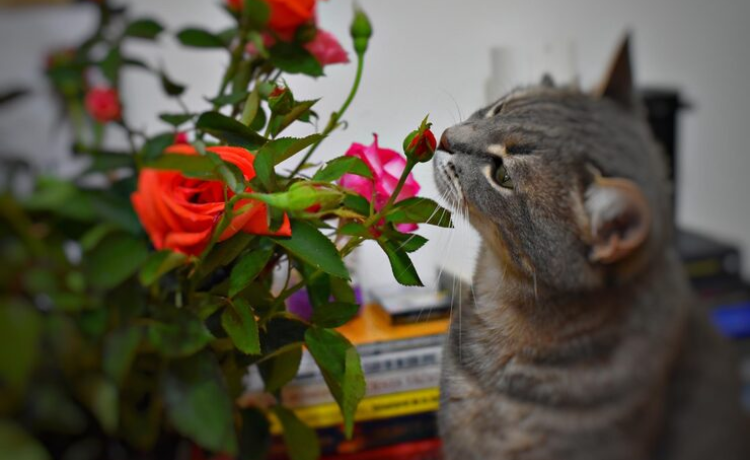Bringing fresh flowers into your home can brighten up any room, but for cat owners, it brings an extra layer of concern. Many common household plants and bouquets contain flowers that are toxic to our feline friends, posing a serious health risk. With so much conflicting information online, knowing which blooms are safe can be a challenge.This guide is designed to give you peace of mind. We will walk you through a comprehensive list of flowers that flowers safe for cats, explain why plant safety is so critical, and show you how to identify and avoid dangerous varieties. By the end, you’ll have the knowledge to create a beautiful, pet-friendly home where both your flowers and your cat can thrive.
Why Flower Safety Matters for Your Cat
A cat’s curiosity can sometimes lead them into trouble. They often explore the world with their mouths, and that includes nibbling on plants and flowers. Unfortunately, this natural behavior can be dangerous. Cat poisoning from toxic flowers is a serious issue, with symptoms ranging from mild discomfort to life-threatening emergencies.
Certain flowers, like those from the lily family, are extremely toxic to cats. Ingesting even a small part of a lily—including the pollen, leaves, or even the water from the vase—can cause acute kidney failure. Other common flowers like daffodils can lead to severe vomiting, diarrhea, and heart problems. Recognizing the symptoms of poisoning is crucial. If you notice your cat showing signs like lethargy, drooling, vomiting, or loss of appetite after being near a new plant, it’s essential to act quickly.
What are flowers safe for cats?
The good news is that you don’t have to give up on having beautiful flowers in your home. Many stunning options are completely safe for your curious companion.
Top Non-Toxic Flowers for Cats
If you’re looking for worry-free options, start with these popular, non-toxic flowers. Roses, for example, are a timeless choice that won’t harm your cat if they decide to take a nibble, though you should still be mindful of the thorns. Sunflowers are another cheerful and safe option, bringing a touch of sunshine indoors without the risk. Other safe flowers for cats indoors include gerbera daisies, celosias, and snapdragons. These vibrant blooms add color and life to your space while keeping your pet out of harm’s way.
Flowers That Are Safe for Cats and Dogs
For households with multiple pets, finding pet-friendly flowers that are safe for both cats and dogs is a top priority. Luckily, many options fit the bill. Marigolds are not only beautiful but also non-toxic to both cats and dogs. Orchids are another elegant and safe choice for a multi-pet home. When shopping, look for labels that indicate “pet-friendly flowers” or “flowers safe for pets” to ensure you’re making a safe choice for all your furry family members.
How to Identify Toxic Flowers for Cats
Knowing which flowers to avoid is just as important as knowing which are safe. Being able to identify harmful plants can prevent a potential emergency.
Flowers to Avoid
A recent study highlighted that lilies remain one of the most common causes of plant-related poisoning in cats. All parts of the lily are toxic, and they should be completely avoided in homes with cats. Other harmful plants for cats include poinsettias, which can cause mild irritation, and daffodils, which are significantly more toxic. Tulips, hyacinths, and azaleas are also on the list of flowers to keep far away from your feline friends. Always double-check a flower’s toxicity before bringing it into your home.
Symptoms of Flower Poisoning in Cats
If you suspect your cat has ingested a toxic flower, look for common symptoms of poisoning. These can include vomiting, diarrhea, drooling, difficulty breathing, or tremors. In more severe cases, you might notice lethargy, seizures, or signs of organ failure. If you observe any of these symptoms, contact your veterinarian or an emergency pet poison hotline immediately. Quick action can make a significant difference in the outcome.
Indoor vs. Outdoor Flowers Safe for Cats
Whether you’re decorating your living room or planning your garden, there are plenty of safe floral options for both indoor and outdoor settings.
Best Indoor Flowers for Cats
Creating a pet-safe indoor oasis is easy with the right plants. African violets are a popular choice, offering beautiful blooms without any risk to your cat. Orchids also make a stunning and safe addition to any home. Other indoor flowers safe for cats include the Christmas cactus and certain types of marigolds. These plants allow you to enjoy the beauty of nature indoors without worrying about your cat’s safety.
Outdoor Flowers That Are Safe for Cats
If you have an outdoor space that your cat can access, planting a pet-friendly garden is a great idea. Sunflowers are a fantastic choice for an outdoor garden, as are impatiens and petunias. These outdoor flowers that are safe for cats add beauty to your yard while ensuring your pet can roam freely without risk.
How to Care for Flowers Around Cats
Even with safe flowers, it’s a good idea to take precautions to protect both your plants and your pet.
Proper Placement of Flowers
To prevent your cat from developing a habit of chewing on plants, consider strategic flower placement for pet safety. Place bouquets on high shelves or in rooms that your cat cannot access. Using hanging planters is another effective way to keep flowers out of reach. This not only protects your cat but also helps your floral arrangements last longer.
Educating Your Cat About Flowers
You can also train your cat to leave flowers alone. Use positive reinforcement to reward your cat for staying away from plants. Providing them with their own cat-safe grass or catnip can also redirect their chewing instincts to an acceptable target. Consistent training can teach your cat to admire your flowers from a distance.
DIY Flower Arrangements Safe for Cats
Creating your own bouquets is a fun way to ensure every flower in your arrangement is safe. Start with a base of safe greenery and add a mix of non-toxic blooms like roses, sunflowers, and snapdragons. You can create a beautiful, personalized arrangement that brings color into your home without posing a threat to your cat.
You would also like: “sofa and cat“
Expert Tips on Flower Safety for Cats
When in doubt, always seek professional advice to ensure your home remains a safe environment for your pet.
Consult a Vet Before Introducing New Plants
Before bringing any new plant or flower into your home, it’s always a good idea to consult your veterinarian. They can provide a list of vet-approved flowers and offer advice tailored to your specific pet. This simple step can help you avoid accidental poisoning and keep your cat healthy.
Keep Your Cat’s Health in Mind When Decorating
Ultimately, your cat’s safety should be a top priority when decorating your home. By choosing safe flowers and being mindful of placement, you can create a space that is both beautiful and pet-friendly. Prioritizing pet safety in home décor ensures a happy and healthy environment for everyone.
Create a Safe and Beautiful Home
Choosing flowers safe for cats doesn’t mean sacrificing beauty. With a bit of knowledge and careful planning, you can fill your home with stunning blooms that won’t harm your feline companion. By staying informed about which plants are toxic and taking simple precautions, you can enjoy the best of both worlds a vibrant, flower-filled home and a happy, healthy cat.
Frequently Asked Questions
Are roses safe for cats?
Yes, roses are considered safe for cats. While the petals and leaves are non-toxic, the thorns on the stem can cause scratches or irritation if your cat plays with them. It’s best to remove the thorns before placing them in a vase.
Can cats eat daisies?
Gerbera daisies are non-toxic and safe for cats. However, other varieties of daisies, such as the Shasta daisy or Chrysanthemum daisy, contain compounds that can be mildly toxic, causing gastrointestinal upset if ingested. It’s best to stick with gerbera daisies to be safe.
What should I do if my cat eats a toxic flower?
If you suspect your cat has eaten a toxic flower, contact your veterinarian or the ASPCA Animal Poison Control Center at (888) 426-4435 immediately. Do not try to induce vomiting unless instructed to do so by a professional. If possible, bring a sample of the plant with you to the vet for proper identification.
Are tulips safe for cats?
No, tulips are toxic to cats. The bulbs are the most toxic part and can cause serious symptoms like vomiting, diarrhea, and drooling. It’s best to keep tulips out of your home and garden if you have a cat.
Is lavender safe for cats?
Lavender contains a compound called linalool, which is toxic to cats in high concentrations. While a small nibble is unlikely to cause serious harm, ingestion can lead to nausea and vomiting. It’s best to keep lavender plants out of your cat’s reach.










